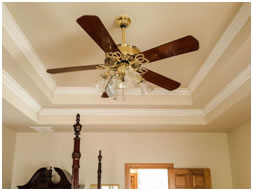
A new ceiling fan is a huge upgrade for a home, especially if you get one of the fancy new ones with smart features. But with so many styles and sizes to choose from, how do you pick the right fan?
When you break down the process of choosing a new ceiling fan into simple steps, it becomes a lot easier. The first thing you need to do is determine what size and type of fan you need. Then you can decide what fan features are important to you and what design you want to match your home decor. You’ll need to think about whether the fan will be exposed to any moisture, and what kind of fan motor is best for your needs.
- Measure Your Room to Choose Your Fan Size and Type
- Ceiling fan sizes are measured according to the sweep of the fan blades, or the diameter of the circle created by the blades when in motion. The sweep is measured in inches. Ceiling fans can be as small as 24 inches or as large as 80 inches – or larger. When you’re shopping for ceiling fans, you need to look at models that are the right size for your room.
- Measure the length and width of your room and multiple those numbers together to arrive at the room’s total square footage. If the room is less than 75 square feet, you need a fan no bigger than 36 inches. If the room is 76 to 144 square feet, you need a fan about 42 inches. For rooms 145 to 224 square feet, you need a fan with a 44-inch sweep. For rooms 225 square feet and above, you need a fan with a minimum sweep of 52 inches – but larger rooms require larger fans and can even require multiple fans.
- It’s also important to know the height of your ceiling, so you can buy the right fan type – either a flush mounting fan, one with a downrod, or one with vertical blades. A ceiling fan should be about seven to nine feet off the floor. If your ceilings are high, you’re going to need a fan with a longer downrod (or you can buy a downrod extension kit). If you have low ceilings, buy a flush mount fan. If you have vaulted or slanted ceilings, vertical blade ceiling fans might be the way to go.
- Choose Your Controls
- These days you can buy a smart ceiling fan that connects to your smartphone and smart home device. Smart connectivity opens up a whole new world of fan features. You could control your smart ceiling fan via voice controls to your smart home device. You can program it to run automatically at certain times of the day. You can turn your fan off and on, or adjust its blade speed or blade direction, from afar – even when you’re not home. Some smart fans even have temperature sensors that signal them to turn on if it gets above a certain temperature in the house.
- Of course, if you don’t want a smart fan, you can still get plenty of great features out of a dumb fan. Most fans have light fixtures built in, and you can always go for wireless wall controls, dimmable light fixtures, easy motor reversal, and remote controls.

- Choose Your Design
- No matter what your personal design aesthetic, you’ll be able to find a ceiling fan that will match it. Choose an industrial-style cage fan, a dual ceiling fan, or a fan with eight or nine blades for a steampunk-inspired industrial look. Buy a palm leaf fan for your beach house, or an organic-looking fan with curved blades for your relaxed and casually modern primary home. Whether you’re looking for a fan that will serve as a focal point or one that will blend in, you have plenty of fan designs to choose from.
- Consider Whether You Need a Wet or Dry Appliance
- Is your new ceiling fan going to be exposed to moisture at all? If you’re hanging it in a kitchen or bathroom, make sure it’s rated for use in damp areas. If you’re hanging a ceiling fan outside, make sure it’s rated for outdoor use – even a fan in a protected area outside needs to be wet-rated. Water has a way of getting in everywhere, and will quickly deteriorate a fan that’s not designed to be waterproof.
- Choose Your Fan Motor
- The quality of the motor can make a huge difference to how a ceiling fan functions. The better the motor, the quieter the fan will be, the more air it will move, and the longer it will last.
- If you want a more affordable fan, you can choose a fan with an AC motor. These motors may not be as quiet and powerful as DC motors, but AC motors have been in use for a long time and they can provide years of service. DC motors, on the other hand, are quieter, more energy efficient, and more powerful (they typically offer six speed settings instead of just three), but they’re also more expensive.
Choosing a new ceiling fan can feel overwhelming, and that’s why it’s important to take it one step at a time. Shop around online and in your favorite big box stores to see what’s out there, then consider what you need from a new ceiling fan, so you can make the right choice for your home and family.
